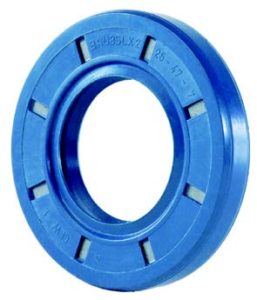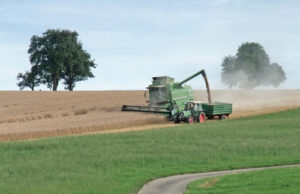 If you evaluate seals by cost, they are C-parts. But if you look at the role sealing plays in machine reliability, seals quickly turn into A-parts. And as requirements and environments progress, sealing designs and technologies must as well.
If you evaluate seals by cost, they are C-parts. But if you look at the role sealing plays in machine reliability, seals quickly turn into A-parts. And as requirements and environments progress, sealing designs and technologies must as well.
Given the latest trends, sealing of the future has the potential to dramatically improve the overall function of mobile machinery. For advancements to be made, sealing companies need to look at their portfolio holistically.
To show the value of a holistic approach, Freudenberg-NOK Sealing Technologies asked experts from three different areas—materials, manufacturing and sales—the same five questions to see how their answers would highlight different aspects of sealing. These experts include:
- Manufacturing: Bob LaPlante, Product Engineering Manager and Nicholas O’Connor, Sr. Product Engineer
- Materials: F. J. Walker, Global Director, Advanced Materials Development
- Sales: Joel Johnson, Global Vice President – Mobile Machinery Sector
 What trends do you see in sealing technologies for agricultural and construction machinery?
What trends do you see in sealing technologies for agricultural and construction machinery?
- Manufacturing Insight: Machines are operating in harsher environments which require seals to function at lower and at higher temperatures, as well as when exposed to elevated contamination levels. As these industries move toward improved efficiency, we are seeing higher shaft surface speeds and higher sub-systems pressures. Our customers are looking for less machine downtime and superior performance, which equates to longer life expectancy and zero tolerance for leakage. We also are seeing movement toward bio-degradable oils, which has driven the development of compatible sealing materials.
- Material Insight: Generally, there are a number of micro-drivers currently impacting material usage, including: emission reduction by lower friction; alternative fuel technologies, including bio-based and CNG (compressed natural gas); next-generation lubricants (for longer drain intervals or fill-for-life, higher temperatures, more aggressive chemistries and lower viscosity); improved longevity (reduced wear, re-useable seal and predictive modeling); legislation for improved sustainability; increasing/constant updates of global, regional and local regulatory requirements; and producibility (advancement in manufacturing technologies, such as our net shape molding process and improved profitability).
- Sales Insight: The industry trends relating to seals are to extend product life, improve fuel economy, reduce downtime and improve machine comfort. The agriculture and construction industries are in an economic trough though, so there is also a high focus on improved performance and lower warranty. Customers are forming Six Sigma teams that focus on problem areas often caused by temperature, oil compatibility, pressure, mating components, assembly or outdated designs.

What are the most important requirements for seals for mobile machines?
- Manufacturing Insight: Identifying application conditions and selecting the correct sealing solution will optimize performance and extend its life. A seal is a part of the tribological system and can‘t function properly if it is used in a wrong way. The balance of the tribological system must be optimized, as well.
- Material Insight: The seal must be designed for the specific application and service environment. This includes the design of the rubber formula in addition to the physical design of the seal. We have to know the environment: temperatures; media (including how the media changes with time and environment); pressures; speeds; etc. to properly design the material and, subsequently, the physical part.
- Sales Insight: We are expected to match the customer needs to a solution. In many cases, there are multiple solutions that can be proposed, ranging from a high-end polymer to an off-the-shelf standard item. Which solution we chose is based on customer input for parameters such as speed, temperature, application, media, pressure and size (S.T.A.M.P.S.). The expected life then becomes important when choosing between multiple solutions.
How do you research new materials?
-

F. J. Walker, Freudenberg NOK Sealing Manufacturing Insight: We work directly with fluid and fluid additive companies to understand current and future trends. Once we have an understanding of the base fluids, additives packages and potential application parameters, we review our current materials portfolio and determine if we already have a compatible material. If we identify a gap in our current portfolio, our experienced chemists initiate a five gate innovation process. Prospective formulations are subjected to immersion testing, standard screening tests (initial standard functional testing) and progress through application simulation functional testing.
- Material Insight: Our materials research team members attend industry forums, trade association-sponsored events, and monitor industry drivers and trends through published information and through personal interactions with key leaders within the market segments. Additionally, this process applies to not only new lubricants and mechanical designs, but emerging technologies covering new polymers, fillers and chemicals. As new technologies are discussed, baseline analysis with existing materials offerings is done. This allows us to establish whether or not there is a technical gap that requires closure through design of new materials.
- Sales Insight: Freudenberg-NOK is one of the few companies that is truly vertically integrated when it comes to material development. We often refer to it as being a baker, making the cake from scratch rather than buying the cake mix from the store. Our chemists develop materials based on industry trends relating to fluid compatibility, temperature and application. For example, a material for a hydraulic pressure seal has different critical physical parameters than a material for a vibration control mount; there isn’t one standard answer. Again, the voice of the customer is very important to this process.
How do seals fail on mobile machinery and can failure be prevented?
 Manufacturing Insight: Studies have shown that 60 to 65% of early field failures are caused by seal installation issues and/or incorrect shaft surface finish. To address this, we provide best practice installation techniques and installation tool designs along with shaft surface finish requirements and surface machining / finishing parameters to produce an optimized “sealing surface.”
Manufacturing Insight: Studies have shown that 60 to 65% of early field failures are caused by seal installation issues and/or incorrect shaft surface finish. To address this, we provide best practice installation techniques and installation tool designs along with shaft surface finish requirements and surface machining / finishing parameters to produce an optimized “sealing surface.”
Studies have also shown that 85% of long-term failures are from application conditions (operating conditions, sealed medium and sealing environment). Long-term failures are prevented by understanding the full tribological system and worst case scenarios when developing the sealing solution. We encourage customers to engage us as early as possible in the development stages to provide the optimum sealing solution.
- Material Insight: There are numerous causes for seal failures that range from incorrect installation of the seal unit, incorrect design or simply selecting the incorrect material for the application. This is why Freudenberg-NOK likes to partner with our customers to provide expert input into their selection of the material and product design, and even educate them on the correct installation of the seal. During this process, we take particular care in: identifying the operating environment that the seal is expected to function; how we define function; and how we design protocols to predict function.
- Sales Insight: In general, 60 to 65% of seal failures come from installation and improper preparation of the mating components. This is why we spend time doing plant audits for our customers. The remaining reasons are usually environmentally related, as mobile machinery environments can be very harsh. Contamination is the number one problem, followed by excessive exposure to heat and then pressure. In today’s environment, machine manufacturers are forced to install more components into smaller spaces than ever before and expected to provide better output (faster speeds, increased loads, etc.). This causes environmental parameters to rise, the effect of this on the seals often not noticed until prototype testing, which is why we do not encourage blindly using a carry-over sealing system from past machines.
What do you look at in your predevelopment research efforts?
-

Bob LaPlante, Freudenberg NOK Sealing Manufacturing Insight: We focus on the customer’s expectations, requirements and strive to understand the full tribological system while accounting for worst case scenarios. We utilize our global field experience and extensive laboratory test data, in conjunction with computer simulations (Finite Element Analysis) in our development and optimization activities. We have an APE group (Advanced Product Engineering) and an innovation team that utilize SORT (Sealing Opportunity Ranking Tool) and PDP (Product Development Process) as part of our product innovative process.
We also utilize VA/VE (Value Analysis / Value Engineering) as a proven team-oriented, creative, systematic, cross-functional approach that enhances decision making and improves customer satisfaction by maximizing product/process value by identifying functions and their related costs.
- Material Insight: The predevelopment process is designed to take into account the environment for which the final article is expected to operate within. Therefore, the development team must have an understanding of all environments—external and internal (fluids, lubricants, etc.). In addition, service functional environments must also be understood (temperature, frequency, type of loading, etc.). Finally, the method of manufacturing must be a key component of the material design. From these key factors, base polymer and formulation design are selected and the process of creating a material commences, when a rubber sealing element is the product of the predevelopment process. In the case of a thermoplastic sealing element, the same process is followed.
- Sales Insight: We look for the voice of the customer along with a match to our business strategy. At Freudenberg-NOK, we encourage innovation and use a system of phase gates to develop new products, but it is extremely important that each innovation has a customer need. Involving potential customers up front is not always easy, because they are busy people, but we strive to work with our partners to match our innovations with their needs.
What advice do you have for our readers?
-

Joel Johnson, Freudenberg NOK Sealing Manufacturing Insight: Seals are often invisible, but are always essential. It is paramount to fully understand their significance in all applications and treat them like the A-parts that they are. Seals should never be an afterthought; it’s best to engage the sealing experts as early in development as possible.
- Material Insight: Care must be exercised when evaluating suitability of a seal material against new environments. Classical definitions of “compatibility” of a sealing element with its environment must be considered. Today, with increased performance demands and increased demands for longevity, the suitability of a seal material for a specific application should not be trivialized. It has evolved into a science unto itself. Therefore, substitution of lubricants or fluids must be carefully evaluated and should be done with full partnership of the seal supplier.
- Sales Insight: If you are concerned about performance and warranty, please work with a qualified sealing expert to develop a solution rather than picking a legacy item or a catalog part out of convenience. The legacy / standard part very well may be the solution, but each application should be checked. We offer a standard EIS (engineering information sheet), which prompts the user to review the appropriate parameters and are always willing to review this with you. Doing the work up front definitely prevents problems in the future!
Freudenberg-NOK Sealing Technologies
www.fst.com


Leave a Reply